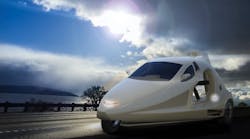Evolutions in transportation always garner attention, usually because it represents pockets of time in our daily lives where most of us would prefer to find faster alternatives. This is true whether it’s the autonomous car, the hyperloop or the idea of the flying car. And while today’s flying car might not exactly match up with the image the verbiage conjures, its ongoing evolution is an undeniable reality.
As Terrafugia Vice President and General Manager Kevin Colburn tells IndustryWeek, roadable aircraft from companies like Terrafugia, Samson Sky and PAL-V all need runways to take off and land. “They are designed to take advantage of the vast, nationwide network of existing airports. Such airports are typically not located directly in cities, but our market research indicates a healthy demand from people who can save time reaching their destination by leveraging small airports very near their origin and very near their destination,” he says. Of course, this is just the start explains Colburn. “There will certainly be opportunities to integrate data from these vehicles into a smart-city data management architecture, but given that many or most of these vehicles will be privately owned and operated, there might not be as much value for the city in asset management as there might be for buses and other urban vehicles,” he says. “The value in our roadable aircraft for smart cities is more likely to be in learning customer preferences and new transportation patterns that will emerge as these vehicles enter the market and are used in new ways. Such data could inform asset management policy as shared-use vertical takeoff and landing vehicles are developed in the future, once the infrastructure and regulation details are determined.”
Paving the way
The young industry reached a meaningful milestone on July 24, when New Hampshire Governor Sununu signed HB1182 into law, making it the first state in the country to create a legal framework for registering, inspecting and plating roadable aircraft. This framework will allow a simple and clean integration of this new means of transportation into state roadways and reinforces New Hampshire’s commitment to supporting innovation and new technologies in the state. HB1182 establishes procedures enabling roadable aircraft to utilize the infrastructure available to other motorized vehicles, however prohibiting the landing or taking off on public roads.
Three leading manufacturers in the roadable aircraft sector PAL-V, Samson Sky and Terrafugia joined forces to meet with legislators and policymakers to provide critical practical knowledge and expertise about the roadable aircraft industry and current practical solutions to registering and inspecting roadable aircraft in New Hampshire. Being first to establish laws for the industry, New Hampshire sets a model for other states to closely consider and in turn, replicate as the future of roadable aircraft is explored.
“One key is establishing registration, inspection, and plating regulations in other states, given that the roadways are governed at the state level,” says Colburn. “It will make it much easier for our industry if the regulations are the same or similar in most states. Another key is a familiar one to any producer of goods: ramping up production while maintaining quality and expanding distribution, sales, and after-sales service offerings.”
Looking forward, PAL-V’s Mark Jennings Bates of PAL-V tells IndustryWeek, "The key to adding regulations in more locations is clearly boiled down to state to state agreements or reciprocity. New Hampshire has created a footprint already for that to continue to evolve."




